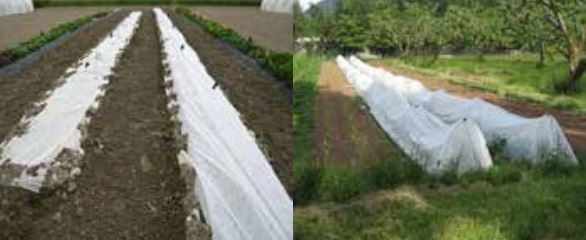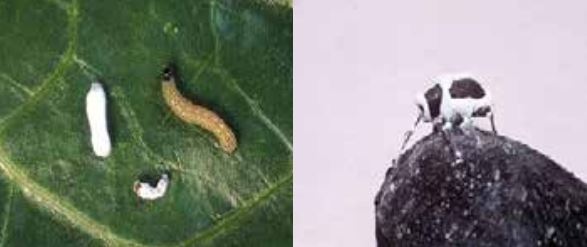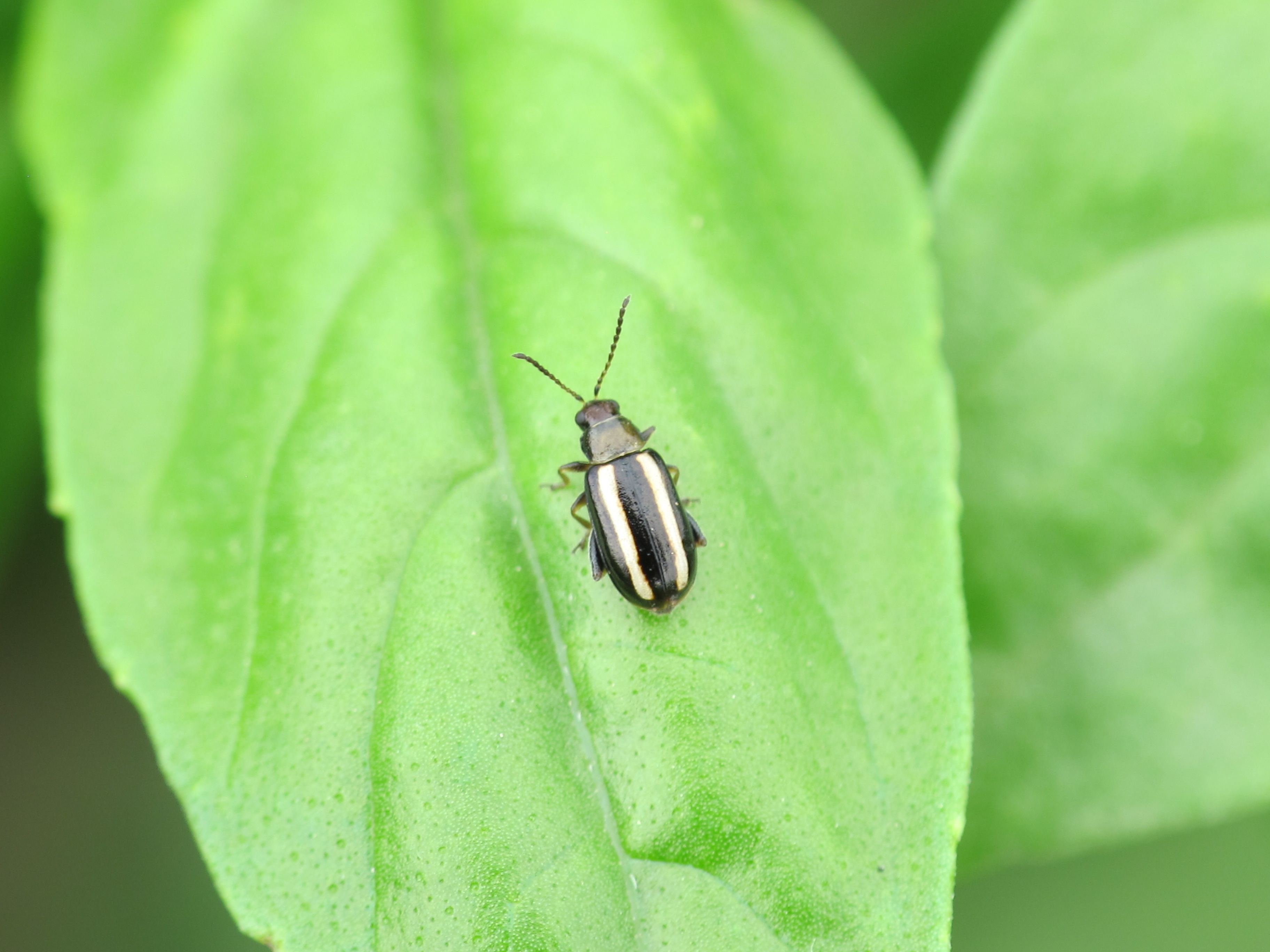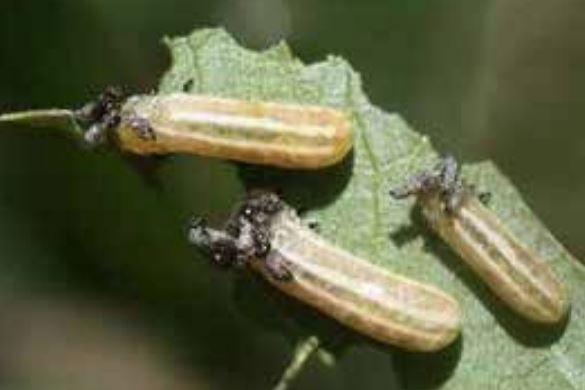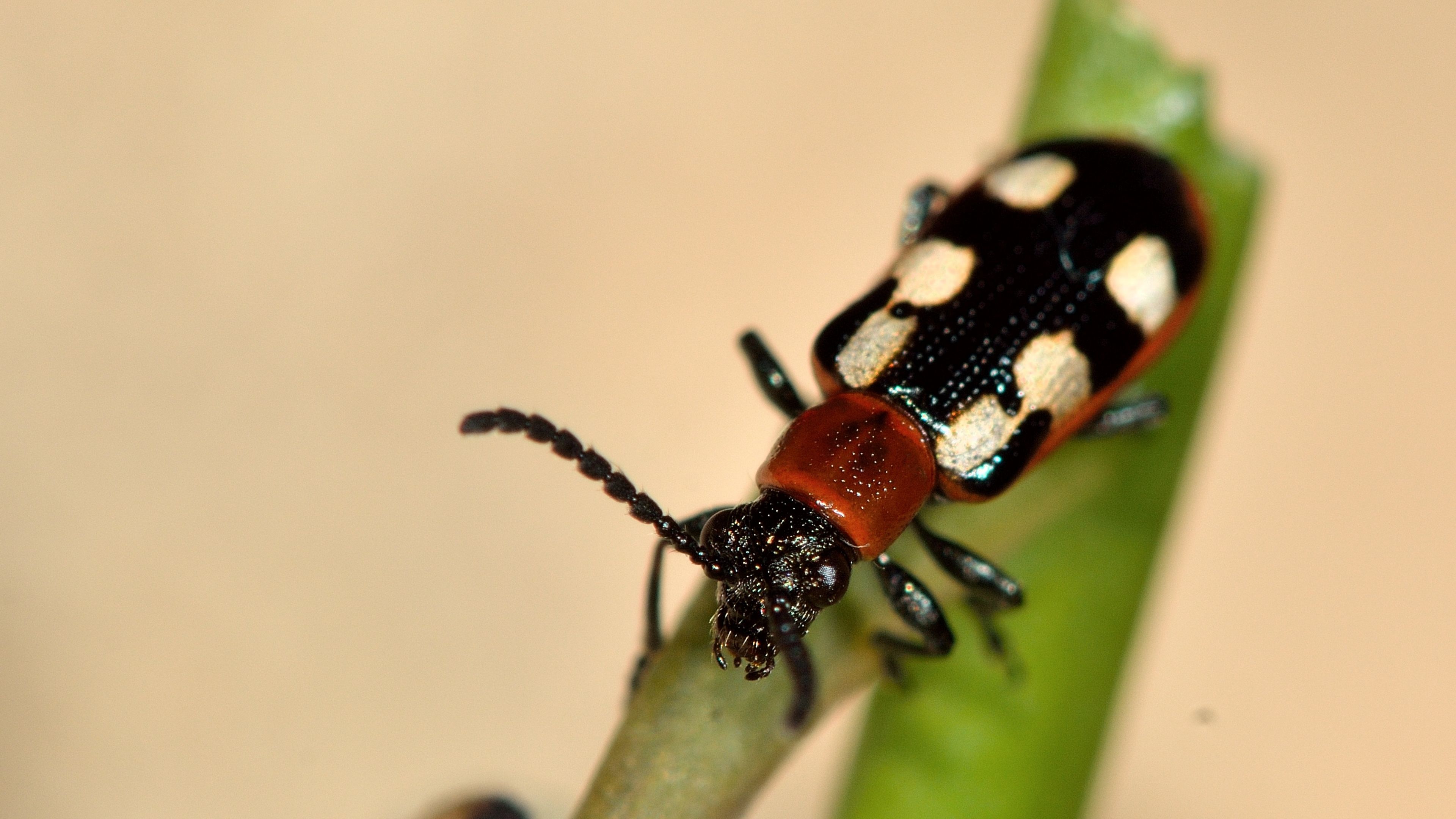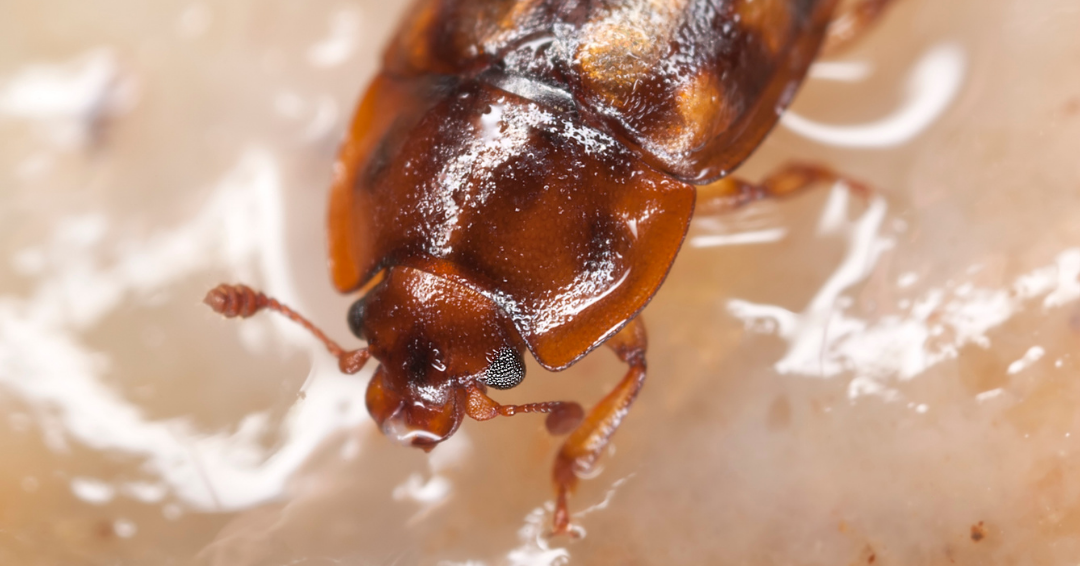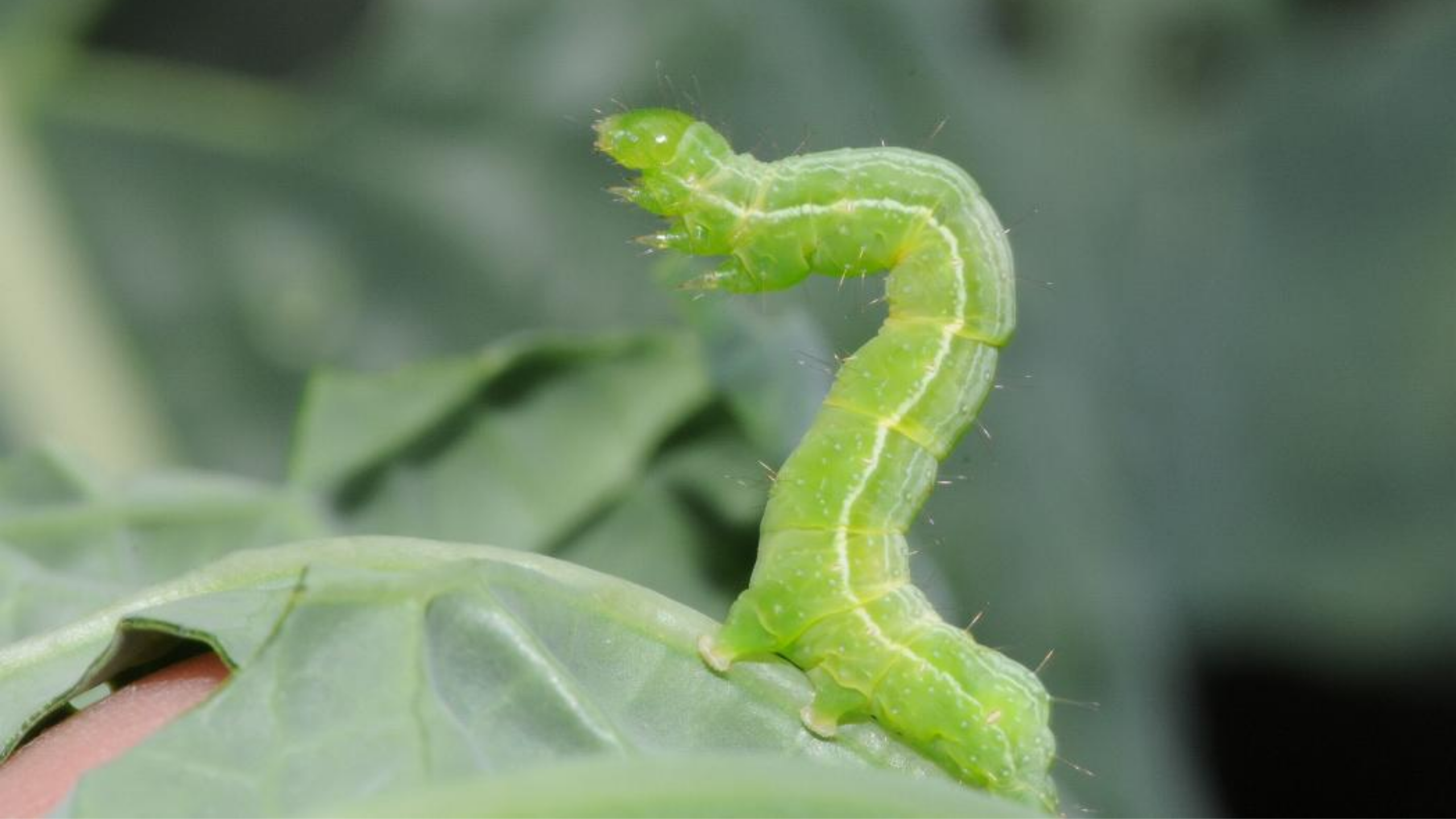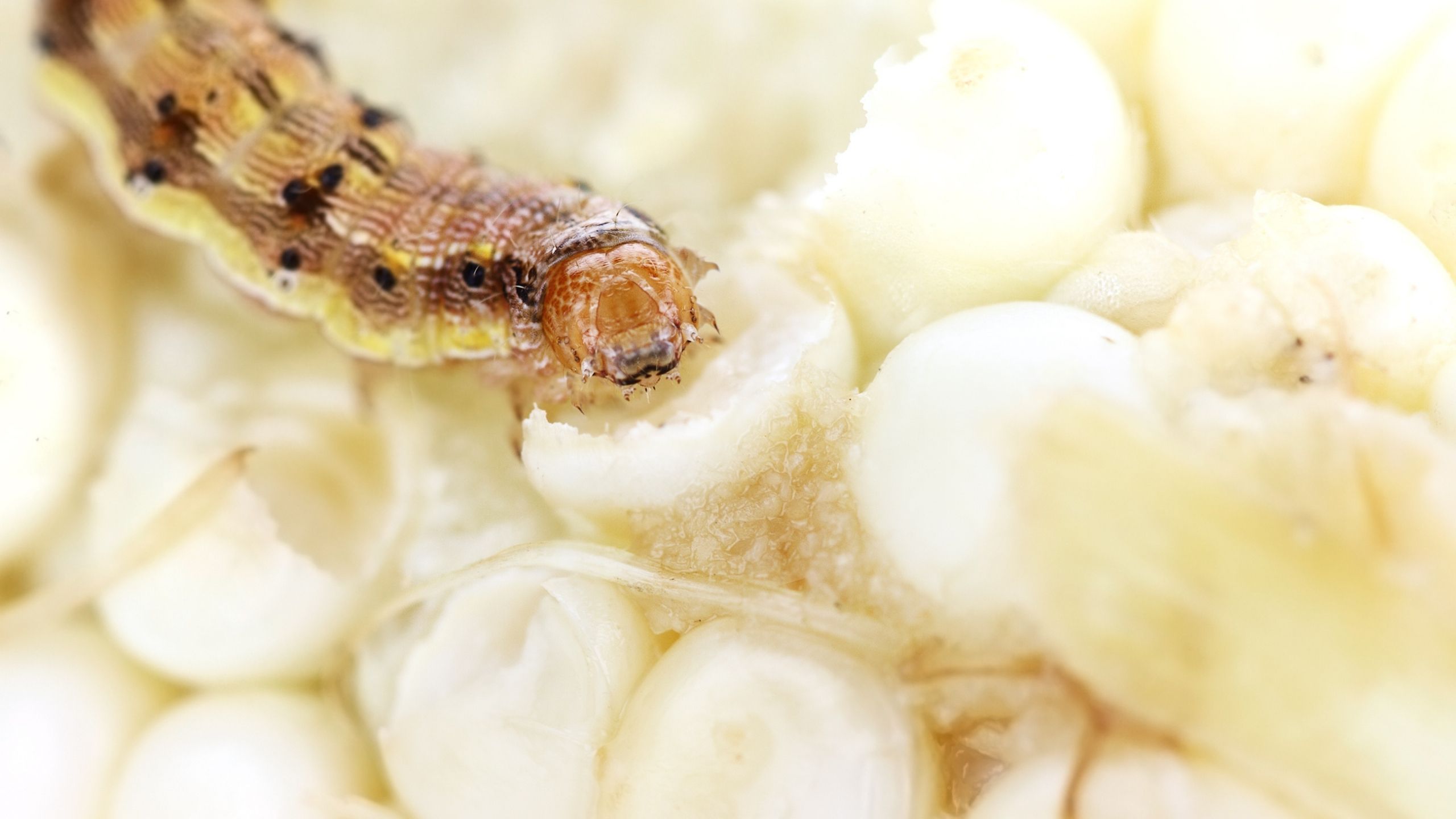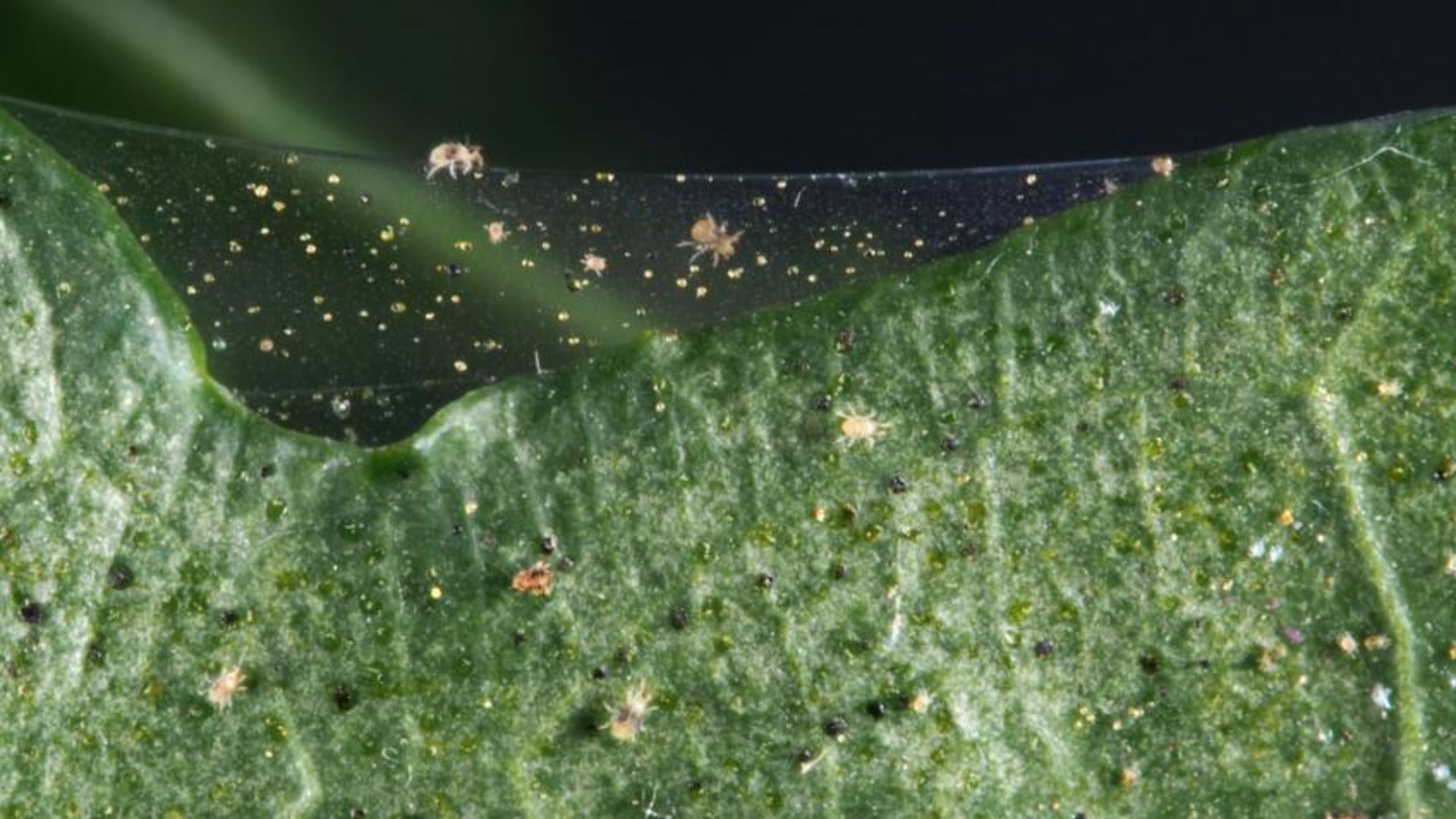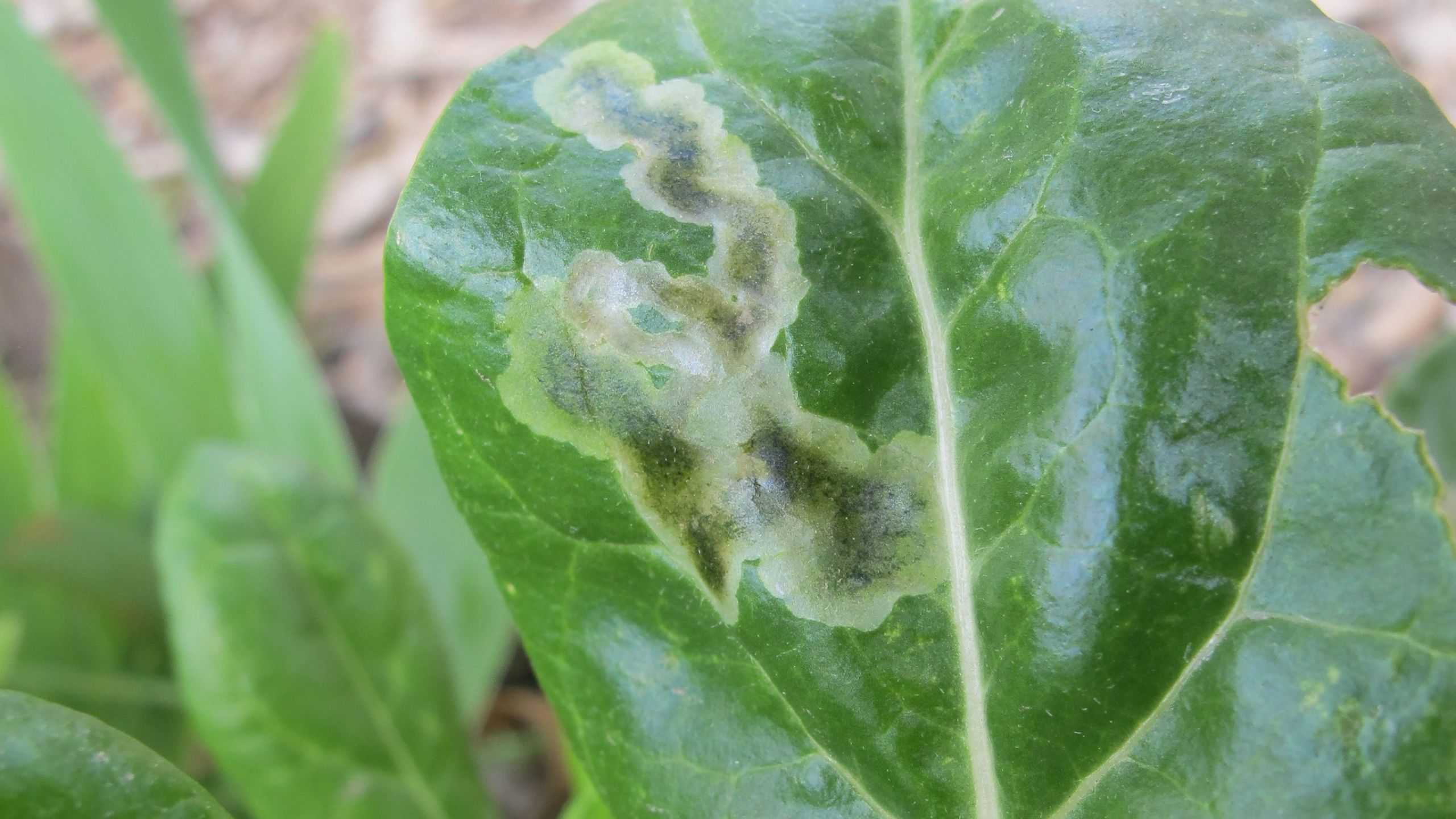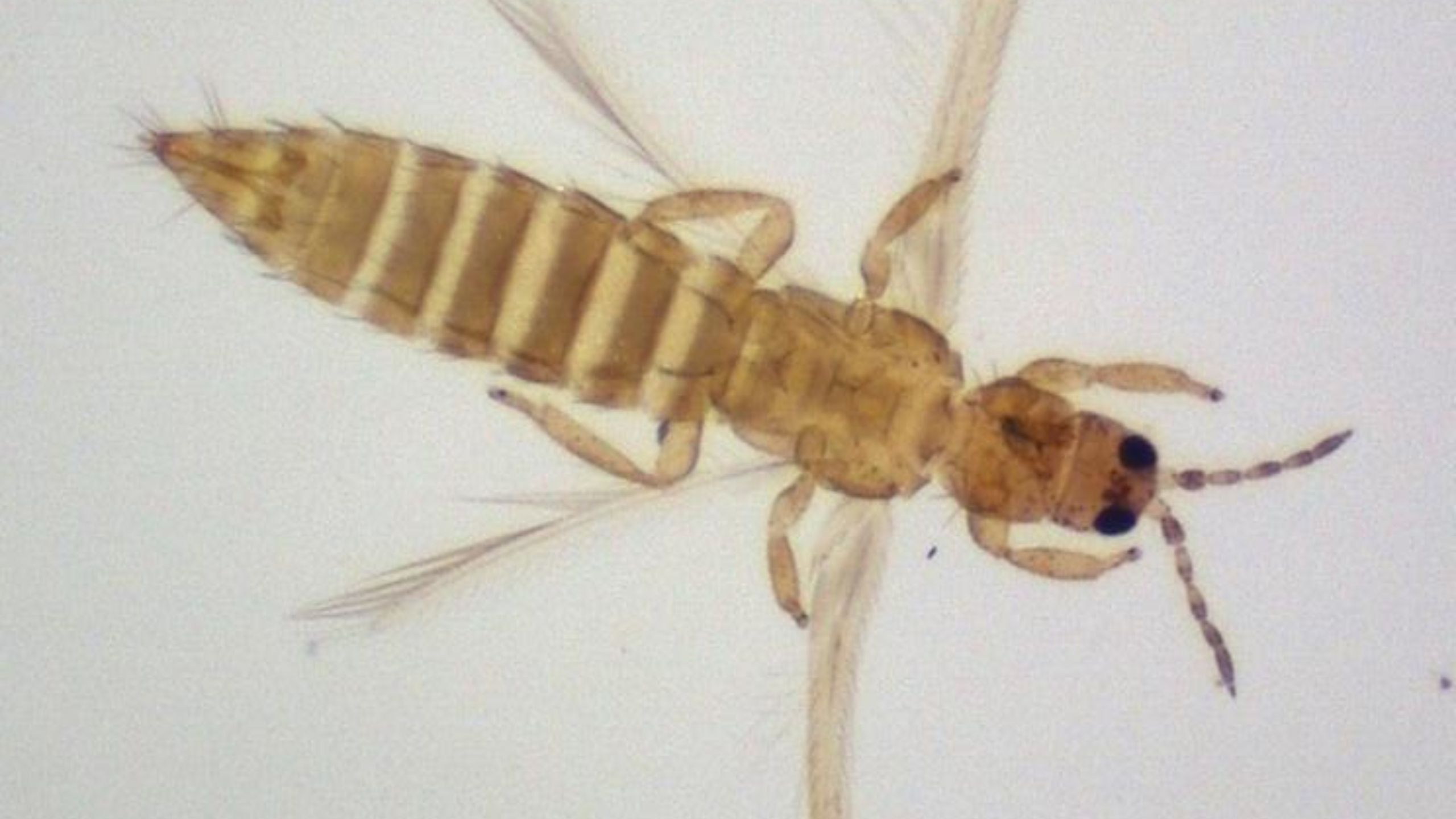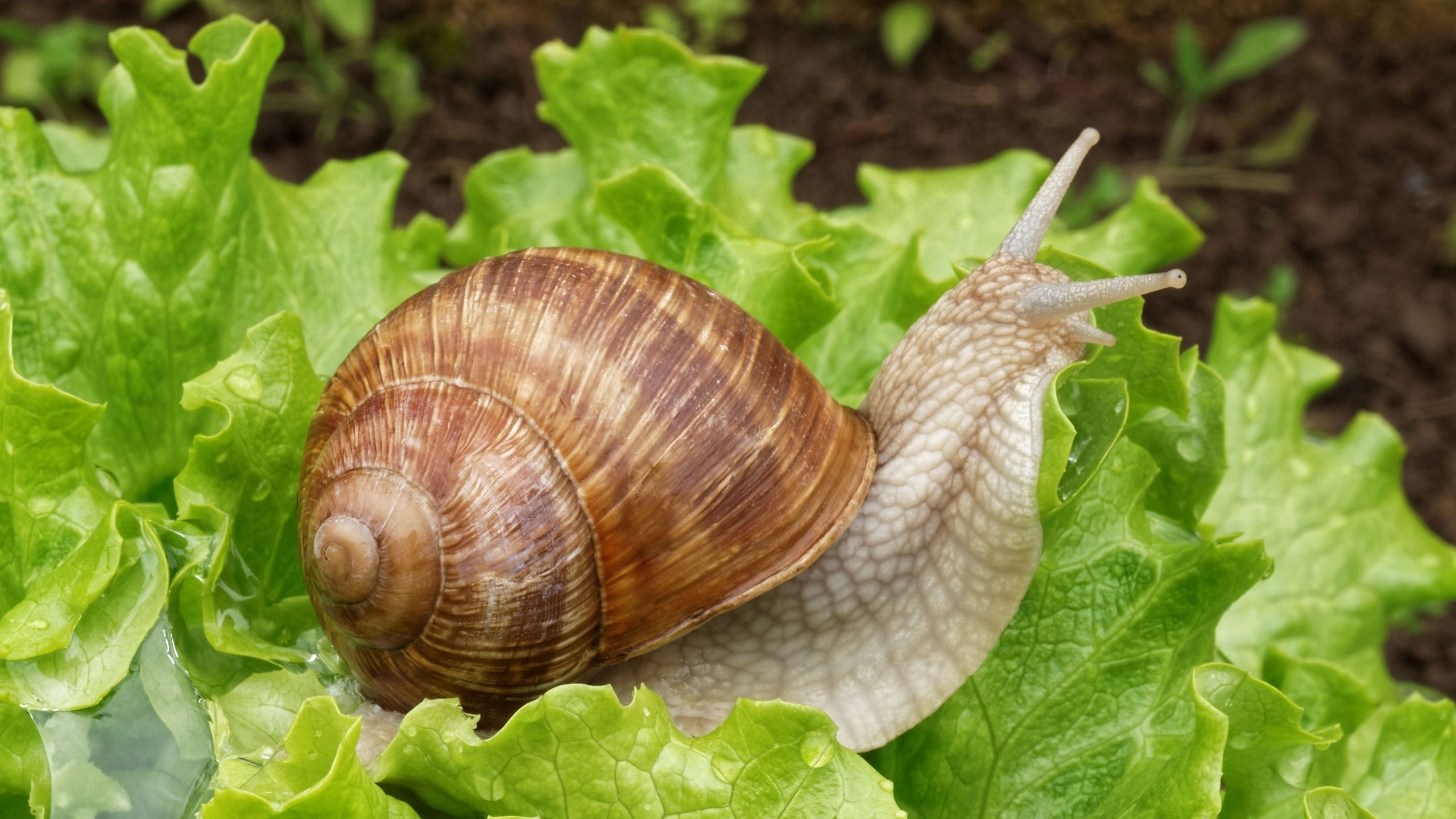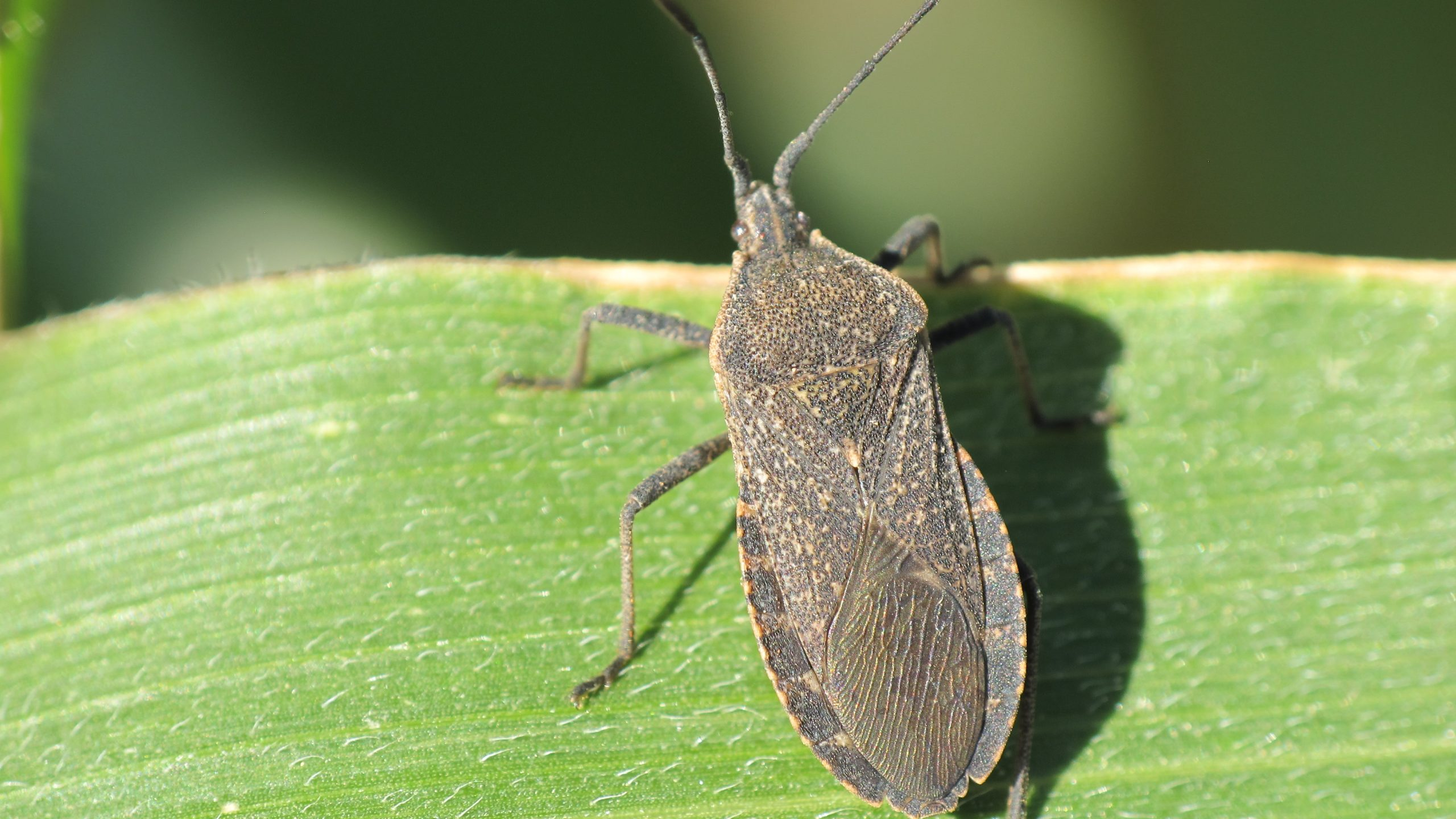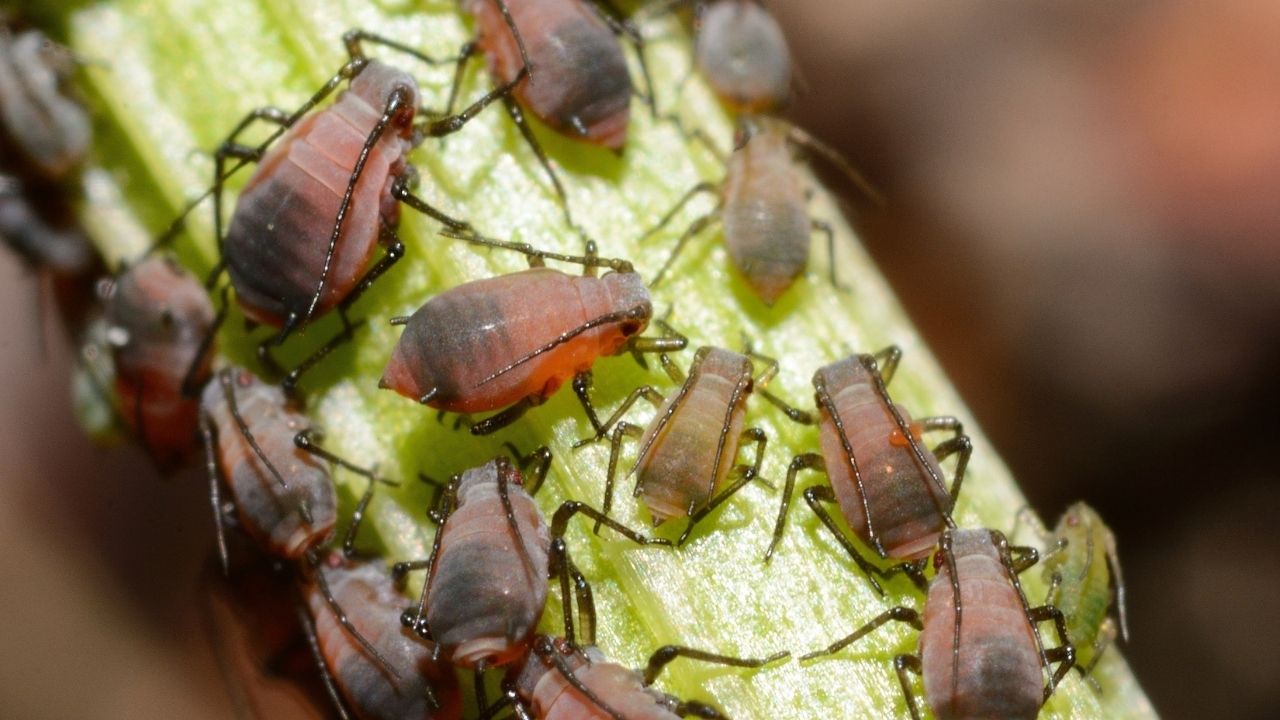Flea Beetles on Vegetables
April 2015
Bonnie Bunn, Vegetable IPM Associate • Diane Alston, Extension Entomologist (No longer at USU) • Marion Murray, Extension IPM Specialist

Fig. 1. Flea beetles have enlarged femoral hind legs and jump when disturbed. Image courtesy of Agriculture Canada, Ottawa Archive, Bugwood.org.
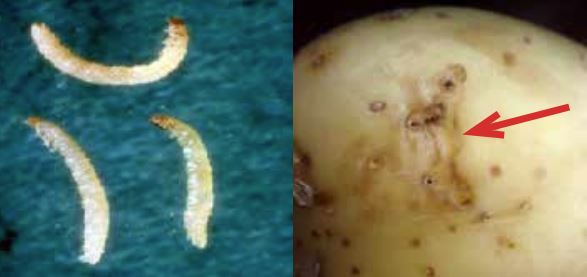
Fig. 2. Tuber flea beetle larvae (left) create shallow tunnels on potato tubers (right). Image courtesy of G.H. Spitler, Washington State University (right) and Agriculture Canada, Ottawa Archive, Bugwood.org (left).
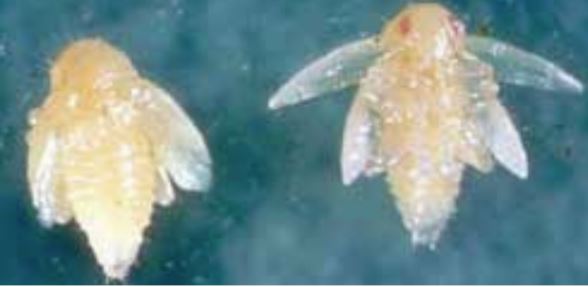
Fig. 3. Flea beetles pupate in the soil and emerge as adults in mid-spring to mid-summer. Image courtesy of Agriculture Canada, Ottawa Archive, Bugwood.org.
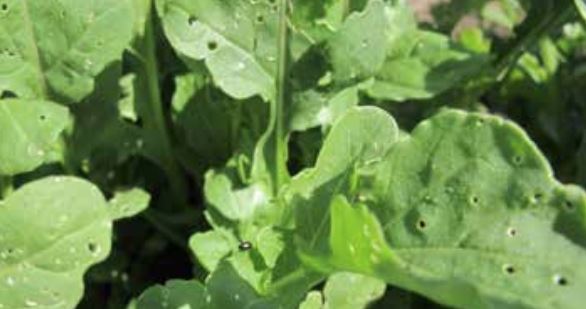
Fig. 4. Flea beetle injury appears as roundish holes characteristically known as “shotholes.”
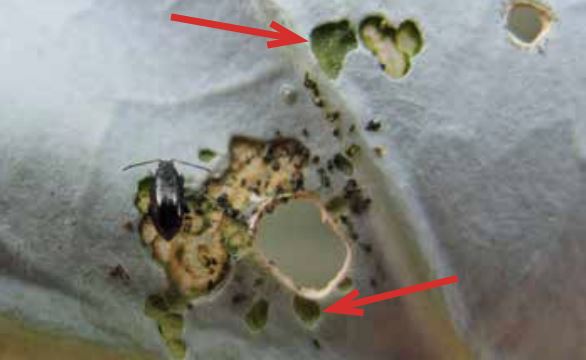
Fig. 5. Feeding by adult flea beetles can also cause pitting on plants that have thick waxy leaves such as on broccoli.
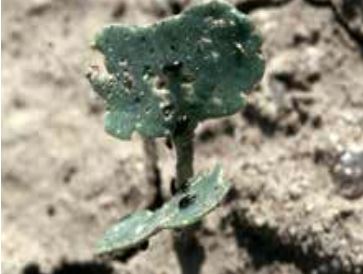
Fig. 6. Flea beetles can be economically damaging to seedlings. Image courtesy of Whitney Cranshaw, Colorado State University, Bugwood.org.

Fig. 7. Example of a mature mustard trap crop in between two rows of broccoli seedlings (cash crop). Image courtesy of Joyce Parker, Washington State University.
Fig. 8. Example of spring onions (companion plant) being used to repel flea beetles away from broccoli. Image courtesy of Joyce Parker, Washington State University.
Fig. 9. Row covers are used to protect crops from insects and can be placed directly over the crop and secured with soil (left) or over hoops and secured with clips and rocks (right). Image courtesy of Carol Miles, Washington State University.
Fig. 10. White muscadine, caused by the fungus Beauvaria bassiana, can affect both larval and adult stages in many insects. A healthy armyworm next to two dead armyworms infected with B. bassiana (left)8. White muscadine on an adult pecan weevil (right). Image courtesy ofLouis Tedders, USDA Agricultural Research Service, Bugwood.org.
Western black flea beetle (Phyllotreta pusilla) is a small, shiny black species. It occurs throughout much of the western half of the northern U. S. and southern Canada. It has a considerably wider host range than other members of this genus.
Palestriped flea beetle (Sestena blanda) is not only one of the most widely distributed flea beetles of North America, but also has the broadest host range. The palestriped flea beetle is one of the larger species (1/8 inch long).
Tobacco flea beetle (Epitrix hirtipennis) commonly feeds on eggplant, tobacco, and potato. It has bronze coloration and is predominant in the southern half of the U.S.
Sumac flea beetle (Blepharida rhois) is a moderate sized beetle. It has cream colored wing covers with irregular, wavy reddish markings and an orange prothorax. Overwintered adult beetles move to sumac in the spring shortly after bud break and feed on the emerging growth. Image courtesy of Joseph Berger, Bugwood.org.
Sumac flea beetle egg masses laid on a skunkbrush twig. Unlike most species of flea beetles, sumac flea beetle females lay eggs in small masses on the twigs and leaves of their host instead of in the soil. Image courtesy of Whitney Cranshaw, Colorado State University, Bugwood.org.
Larvae of sumac flea beetles are grayish, with a cylindrical body form. They are slightly shiny and carry frass (insect feces) containing toxins derived from their sumac host on their back. The larvae use the frass as a shield to protect themselves from ants and other predators. Image courtesy of Whitney Cranshaw, Colorado State University, Bugwood.org.
Quick Facts
- There are many species of flea beetles; most adults are small, darkly colored, sometimes shiny or metallic, and jump quickly when disturbed.
- Flea beetles attack foliage of brassica and solanaceous crops, and some root crops including potato tubers.
- Young vegetable seedlings are most sensitive to adult feeding injury, which often appears as small shotholes and pitting in leaves and cotyledons.
- Key management practices include early monitoring for injury and using row covers, trap crops, mulches,
Flea beetles are common and problematic in Utah. They are present in late spring and early summer on many vegetable crops and ornamental plants. Adult flea beetles are small, shiny insects that have enlarged hind legs, allowing them to jump great distances when disturbed (Fig 1). They are strong fliers, moving into crops from neighboring fields and weedy borders.
Hosts
Most species of flea beetle attack only one plant group or closely related groups. Common agricultural and garden hosts include members of the brassica (mustard, broccoli, kale, cabbage, collards, etc.) and solanaceous (potatoes, tomatoes, eggplant, peppers, etc.) families. In these crops, foliage injury from adults is common, and larval injury to potato tubers is of economic importance. Other hosts include alder, currant, evening primrose, sedum, skunkbrush, sumac, willow, and a variety of weeds and grasses.
Description
Adult - Overwintering and Damaging Stage
- Typically range from 1/15 to 1/6 inch (1.7 to 4.2 mm) long
- Hind legs are enlarged for jumping
- Range in color from brown, green, metallic-blue to black; may have stripes or spots
- Feed on foliage and can cause severe injury on some host plants (pitting and holes in leaves)
Egg
- Elliptical in shape, 1/64 inch (0.4 mm) long
- White to yellowish-gray
Larva - Damaging Stage
- Minute, worm-like
- White body with brown head (Fig. 2)
- Usually does not cause significant plant injury, except to potato tubers and possibly carrots (Fig. 2)
Pupa - Resting Stage
- Occurs several inches deep in the soil (Fig. 3)
Life History
Most flea beetle species overwinter as adults in protected places such as under leaf litter, dirt clods, or on weeds along field borders and ditch banks. Adults become active in mid-to late spring and feed on weeds and other available plants. When their preferred host plants become available, and/or when weeds dry up, the adult flea beetle will move to nearby fields or vegetable gardens.
After several weeks of feeding, adults of most species of flea beetles begin laying eggs in the soil at the base of desirable host plants. Minute, worm-like larvae hatch and begin feeding on small roots and root hairs. For a few species of flea beetles that develop above ground, eggs are laid in masses on leaves or twigs and young larvae feed on leaves producing skeletonizing injury similar to other leaf beetles. The larval stage typically lasts about a month; then they pupate and emerge as the second generation of adults in late spring to mid-summer. A third generation may occur for some flea beetle species.
Injury
Flea beetle adults use visual and chemical olfactory (smell) cues to find host plants. They chew holes or pits into leaves and cotyledons. On plants with thinner leaves, such as mustard and potato, adult feeding causes small, rounded holes characteristically described as “shotholes” [1/16 to 1/8 inch (1.5 to 3.2 mm) in diameter] (Fig. 4). On plants with leaves that are waxy and thick, such as broccoli, injury appears as pitting (Fig. 5).
Leafy mustard greens are at high risk for unsightly shotholes and scars that can reduce marketability; however, for mature or less sensitive plants, more than 20% of the leaf area must typically be damaged before yields are reduced. In contrast, seedlings and small transplants are at high risk for damage, especially under heavy infestations (Fig. 6).
The larvae of most flea beetle species feed on small roots or root hairs which may slightly reduce plant health and vigor, but typically does not result in substantial economic loss. An exception is damage by the tuber flea beetle larvae to potato tubers. When larvae feed on the surface of potato tubers they cause winding, shallow grooves (Fig. 2). They can also burrow into the tubers, leaving tunnels filled with frass (excrement) that can stain potato tubers. In California, flea beetle larvae were found feeding on the roots of carrots and causing injury similar to the fungal disease cavity spot. Flea beetle larvae damage to carrots and other root vegetables are suspected in Utah, but have not been confirmed.
Some flea beetle species can vector pathogens that cause diseases. Stewart’s bacterial wilt, caused by Erwinia stewartii, is one of the more serious flea beetle vectored diseases, especially in the corn-producing regions of eastern United States. The bacterium survives in the gut of overwintering corn flea beetles. The disease is spread when adults begin feeding in the spring.
Other diseases in vegetables that are vectored by flea beetles include brown rot, spindle tuber disease, black rot, and Alternaria leaf spot. Most diseases are spread indirectly by flea beetles when they feed, creating openings in plant tissue that allow pathogens carried on their bodies or in their feces to enter. In general, these diseases are not common in Utah.
Monitoring
- Scout Plants. It is important to look for flea beetles on susceptible plants, especially in the spring. Check seedlings at least two times a week until they grow out of their vulnerable stage (4 to 5 true leaves). Since injury to seedlings can be severe, a treatment guideline is 1 to 5 flea beetles per plant. In mature plants, treatment may be necessary when flea beetle populations are high, or on plants that are more susceptible to feeding, such as leafy greens and ornamentals.
- Sticky Traps. Sticky traps are a monitoring tool that provide a guideline of when beetles are present and in what quantity, but are ineffective in reducing populations. Either yellow or white sticky traps can be used. They should be placed around susceptible host plants just after planting but before seedlings emerge. Replace them when the adhesive is covered by insects or no longer sticky. Sticky traps can be used until plants are well established or until harvest. They will also attract some beneficial insects, including pollinators, so consider this negative attribute when planning to use them. Refer to the list of trap sources at the end of this fact sheet for further information.
Management
The high mobility of flea beetles can make management more challenging. Understanding their biology and life cycle will help identify effective strategies and optimal timings to reduce their negative impacts. When management of flea beetles is warranted, a combination of cultural, physical, biological, and chemical options should be used.
Cultural and Mechanical Control
- Planting Schedule. Adjusting planting times to avoid peak adult activity periods will lessen plant injury and improve tolerance to feeding injury. Planting early, such as under protective covers and into soil-warming mulches, advances plant maturity before flight peaks and also increases plant tolerance. In contrast, planting late may avoid early-season larval injury and heavy feeding by overwintering adults. Waiting to plant until late spring also allows soils to warm, providing better conditions for plants to outgrow and compensate for flea beetle injury.
- Healthy Plants. Promote healthy, fast-growing plants by ensuring the seedbed is well-prepared, and that essential nutrients and water are available. Providing good nutrition and favorable growing conditions will shorten the vulnerable early-growth stages and increase plant survival from flea beetle attack.
- Trap Crops. Plants that are highly attractive to flea beetles can serve as a trap crop. Trap crops lure flea beetles away from the desired (cash) crop, and can be destroyed or sprayed to decrease the flea beetle population. Plant the trap crop about 2 to 4 weeks before the cash crop so that the larger, well-maintained trap crop will be more attractive to flea beetles (Fig. 7). Some examples of successful trap crops for flea beetles include Chinese southern giant mustard, radish, daikon, pac choi, and pacific gold mustard. Once flea beetles start to feed on the trap crop, their populations can be managed. One option is to vacuum them with a shop vac and dump the contents into a bucket of soapy water. Synthetic or organically approved insecticides may also be sprayed on the trap crop to kill flea beetles present.
- Companion Plants. Companion plants can confuse, repel, or block insect pests from finding host plants. Bunching green onions, dill, and marigolds are a few examples of companion crops that have been used for flea beetle management (Fig. 8). Intercropping or planting companion plants next to host plants will enhance plant diversity and make the desired crop less apparent to the beetles. Companion plants can also be used in combination with trap crops to increase success with pest control. The companion plant repels flea beetles from host plants, while the trap crop attracts the flea beetles. This is called a “push-pull” strategy.
Mechanical Control
- Traps that attract adults and nymphs seeking protection include wooden boards, shingles, and heavy cardboard placed on the ground. Place the trap materials next to plant rows. Squash bugs will tend to aggregate under the traps at night. In the morning, turn the boards over and destroy the bugs mechanically or with insecticides.
- Row Covers. Floating row covers or plant fabrics (e.g., Reemay™, Agriforce™, Agribon™, Tufbell™) can prevent adult squash bugs from locating and landing on cucurbit crops in the late spring and early summer. Row covers must be tightly secured to prevent bugs from accessing plants. Covers must be removed when plants begin to flower for pollination to occur. Also, weed control under covers must be maintained by mulches, pre-emergent herbicides, or occasional removal of covers to physically remove weeds. Row covers may be more practical for organic and small commercial fields, and home gardens. The cost of plant fabric and the logistics of keeping floating covers secured on long plant rows make it less practical for large commercial fields.
- Hand-picking adults and nymphs, and smashing egg clusters on leaves can reduce squash bug populations. This technique will be most successful if started early in the season and done every 2 to 3 days to keep numbers low. Mechanical destruction of squash bugs is most suitable for home gardens and small plantings.
- Mulches. Living mulches are crops that can be interplanted with or under-sown in a cash crop. These mulches can obscure host plants from flea beetles and provide habitats for ground-dwelling beneficial insects such as predatory ground beetles. Plants that are commonly used as living mulches include legumes such as clover and vetch. Non-living mulches such as barley straw, leaf mulch, and plastic mulches (e.g., weed barrier and landscape fabric), interfere with the root and soil stages of flea beetles, and may also inhibit adult egg-laying.
- Sanitation. Adults overwinter under soil clods and plant debris; therefore, good sanitation practices are important to reduce overwintering flea beetle populations. Remove or destroy refuge sites by plowing or rototilling crop residues and weeds in the fall. Weeds that are particularly troublesome include those in the mustard family. Mustard weeds that are common in the spring in Utah include shepherdspurse, hoary cress, blue mustard, flixweed, dyer’s woad, perennial pepperweed, and tumble mustard.
- Floating Row Covers. Row covers are white, light-weight fabrics made from spun-bonded polyester or polypropylene. They are permeable to light, water, and air. Row covers are used to cover plants to create a physical barrier against pest insects, diseases, and some environmental stresses, such as frost (Fig. 9). In addition, row covers can be used to extend the growing season by conserving heat. Install the floating row cover over the crop before flea beetles appear, and secure well on all sides. It is important to remember that flea beetles can overwinter in the garden (under soil clods and plant debris, and on weeds), and they can emerge under row covers placed where host crops grew the previous year. Therefore, row covers should be used in conjunction with a planned crop rotation in which the crop to be protected follows a non-susceptible crop.
Biological Control
- Parasites and Predators. Generalist predators such as larvae of lacewing (Chrysopa spp.), adult big-eyed bugs (Geocoris spp.) and damsel bugs (Nabis spp.) feed on adult flea beetles. Additionally, a parasitoid wasp (Microctonus vittatae) can kill some species of adult flea beetles. These beneficial insects are attracted to nectar and pollen–producing plants such as anise, chamomile, clover, dill, and marigold.
- Nematodes. Entomopathogenic nematodes are soildwelling parasitic worms that kill insects that live in the soil, including flea beetle larvae. Entomopathogenic nematodes (Steinernema spp. and Heterorhabditis spp.) can attack the flea beetle larvae, reducing the subsequent adult populations. They can be purchased from suppliers (see the end of this fact sheet) and watered into the soil according to directions.
- Fungal Pathogens. White muscadine, a disease that can reduce flea beetle populations, is caused by the fungus Beauvaria bassiana. When insects come into contact with the fungal spores, the spores attach to the insect, germinate, and penetrate the insect’s body. The fungus releases toxins that liquefy the internal contents of the insect, creating a food source for the fungus and subsequently killing the insect (Fig. 10). Since sunlight can dry out and kill spores, applying commercially formulated B. bassiana products in the evening and in humid conditions will improve their efficacy.
Chemical Control
Although foliar application of insecticides is the most common management tactic for flea beetles, insecticides should only be used if necessary. Since plants produce continuous new growth and the highly mobile beetles can rapidly reinvade plantings, insecticides may have to be applied more than once to cover the plant’s susceptible period.
Table 1. Examples of effective home use insecticides registered in Utah that are effetive for flea beetle control.
| Brand Name | Active Ingredient | MoA* | Resididual (Days) |
|---|---|---|---|
| Sevin | carbaryl | 1 | 7-10 |
| Monterey Vegetable Garden Sol Insecticide; Ortho Bug-B-Gone Lawn & Garden Insect Killer | bifenthrin | 3 | 7-10 |
| BioAdvanced Vegetable & Garden Insect Spray | cyfluthrin | 3 | 7-10 |
| Monterey Bug Buster II | esfenvalerate | 3 | 7-10 |
| Bonide Beetle Killer | lamba-cyhalothrin | 3 | 7-10 |
| BioAdvanced Complete Insect Killer, Bonide Eight | permethrin | 3 | 3 |
| Bonide Pyrethrin Garden Insect Spray, Fertilome Triple Action Plus, Ortho Garden Insect Killer, Worry Free ome Pest Control | pyrethrin | 3 | 3 |
| Ortho Flower, Fruit, & Vegetable Insect Killer | acetamiprid | 4 | 5-14 |
| Bayer Fruit, Citrus, & Vegetable Insect Control, Monterey Fruit Tree, & Vegetable Systemic Soil Drench | imidacloprid | 4 | 5-14 |
| Bonide Captain Jack's Deadbug Brew, Green Light, Monterey Garden Insect SprayO | spinosad | 5 | 4-7 |
| Bonide, Desect, Garden Safe, Safer | diatomaceous earth (silicon dioxide) | 1-3 |
Table 2. Examples of effective commercial use insecticides registered in Utah that are effetive for flea beetle control.
| Brand Name | Active Ingredient | MoA* | Resididual (Days) |
|---|---|---|---|
| Malathion | malathion | 1 | 5-7 |
| BrigadeR, CaptureR, DisciplineR, HeroR, TundraR | bifenthrin | 3 | 7-14 |
| HeroR | bifenthrin / zeta-cypermethrin | 3 | 7-14 |
| RenounceR, TombstoneR | cyfluthrin | 3 | 7-14 |
| AsanaR | esfenvalerate | 3 | 7-14 |
| AmbushR, PounceR | permethrin | 3 | 3-10 |
| PyganicO | pyrethrin | 3 | 3 |
| Assail | acetamiprid | 4 | 5-14 |
| Admire Pro, Alias | imidacloprid | 4 | 5-14 |
| Scorpion, Venom | dinotefuran | 4 | 7-14 |
| Success, EntrustO | spinosad | 5 | 4-7 |
| AzatrolO, EcozinO, Molt | azadirachtin | UN | 7-10 |
*Insecticide mode-of-action (MOA) classification number based on guidelines from the Insecticide Resistance Action Committee. Rotate
among insecticide classes to reduce the development of resistance.
O Organically certified insecticide products.
R Restricted use products that require an applicator license.
Note: All brand names are registered trademarks. Examples of brands may not be all-inclusive, but are meant to provide examples of
insecticides registered on vegetables in Utah. The availability of insecticides and active ingredients in brands can change. Always check
the label for active ingredient(s), registered uses, application and safety information, and protection and pre-harvest intervals.
Table 3. Flea beetle species that occur in Utah.
| Common Name | Scientific Name | Host Plants, Comments |
|---|---|---|
| Sumac Flea Beetle | Blepharida rhois | Currant, sumac, skunkbrush |
| Toothed Flea Beetle | Chaetocnema denticulata | Corn and other grasses |
| Desert Corn Flea Beetle | Chaetocnema ectypa | Principally corn, but also other grass crops such as barley, sorghum, sudangrass, sugarcane, and wheat |
| Threespotted Flea Beetle | Disonycha triangularis | Principally weeds such as chickweed, purslane, lambsquarters and pigweed; also beet, spinach, Swiss chard, sugarbeet, cabbage, canola, horseradish, lettuce, and radish. It has an orange colored thorax with three prominent dark spots |
| Tobacco Flea Beetle | Epitrix hirtipennis | Eggplant and some other nightshade family plants |
| Western Potato Flea Beetle | Epitrix Subcrinita | Potato, tomato, and other plants in nightshade family |
| Tuber Flea Beetle | Epitrix tuberis | Potato, tomato, and other plants in nightshade family; larvae produce shallow scars in potato tubers |
| Crucifer Flea Beetle | Phyllotreta cruciferae | Wide host range, primarily of cabbage and mustard family plants (Brassicaeae) |
| Western Black Flea Beetle | Phyllotreta pusilla | Occurs throughout much of the northwestern U. S. and injurious to members of the brassica family and other vegetables such as beet, potato, and lettuce |
| Hop Flea Beetle | Psylliodes punctulata | Wide host range including cabbage, cucumber, hops, strawberry, tomato, and beet. One of the first flea beetles to appear in the spring |
| Palestriped Flea Beetle | Systena blanda | Has the widest host range of all flea beetles which includes squash, beans, corn, sunflowers, lettuce, potatoes and many weeds |
| Elongate Flea Beetle | Systena elongate | Closely resembles the palestriped flea beetle and considerably overlaps its geographic and host range |
Further Reading and References
- Ambrosino, M. 2008. Flea Beetle Pest Management for Organic Potatoes. Oregon State University Extension Service EM
8947-E. - Capinera, J. J. 2001. Handbook of Vegetable Pests. Academic Press. San Diego, California, 76 pp.
- Cranshaw, W. S. 2014. Flea Beetles. Colorado State University Extension Fact Sheet No. 5.592.
- Cranshaw, W. S. 2004. Garden Insects of North America: The Ultimate Guide to Backyard Bugs. Princeton University Press.
Princeton, New Jersey, 200 pp. - Kuepper, G. 2003. Flea Beetle: Organic Control Options. Appropriate Technology Transfer for Rural Areas (ATTRA) publication.
- Parker, J., C. Miles, T. Murray, and W. Snyder. 2012. How to Install a Floating Row Cover. Washington State University Extension Publication FS089E.
- Parker, J., C. Miles, T. Murray, W. Snyder. 2012. Organic Management of Flea Beetles. A Pacific Northwest Extension Publication PNW640.
- Parker, J. E., W. E. Snyder, G. C. Hamilton, and C. Rodriguez-Saona. 2013. Companion Planting and Insect Pest Control,
Weed and Pest Control - Conventional and New Challenges, Dr. Sonia Soloneski (Ed.), InTech, DOI: 10.5772/55044.
Related Research



